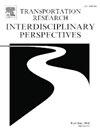Into the Nexus of disability, mobility aid and travel Behavior-A Tale from a South Asian City
IF 3.9
Q2 TRANSPORTATION
Transportation Research Interdisciplinary Perspectives
Pub Date : 2024-11-01
DOI:10.1016/j.trip.2024.101274
引用次数: 0
Abstract
Building a sustainable society and ensuring inclusive urban development must address the transportation needs of persons with disabilities (PWDs). Among PWDs, movement-challenged persons face particularly significant challenges in their daily transportation. Without a proper understanding of the mobility patterns of movement-challenged persons, ensuring the sustainability of the transportation system is impossible. This study aims to explore the mobility patterns of movement-challenged persons in Dhaka, based on a survey of 400 individuals. The findings indicate that walking frame and cane users are more likely to use rickshaws, while wheelchair users prefer traveling by CNG (Compressed Natural Gas) driven vehicles. Walking stick users prioritize door-to-door service when choosing a mode of transport, whereas walking frame/crutch and wheelchair users prioritize convenience. Specifically, movement-challenged persons who use rickshaws and CNGs consider door-to-door service an important factor in their travel mode selection. Survival analysis reveals that wheelchair and walking frame/crutch users are more likely to make shorter trips by walking or wheeling. Statistical modeling indicates that wheelchair users experience longer waiting times and are less inclined to use buses. Additionally, wheelchair users are completely dependent on walking (wheeling) for access and egress, while walking frame/crutch and walking stick users utilize both rickshaws and walking for these purposes. The study provides design and technology-oriented recommendations to improve accessibility of transportation modes for movement-challenged persons.
求助全文
约1分钟内获得全文
求助全文
来源期刊

Transportation Research Interdisciplinary Perspectives
Engineering-Automotive Engineering
CiteScore
12.90
自引率
0.00%
发文量
185
审稿时长
22 weeks
 求助内容:
求助内容: 应助结果提醒方式:
应助结果提醒方式:


